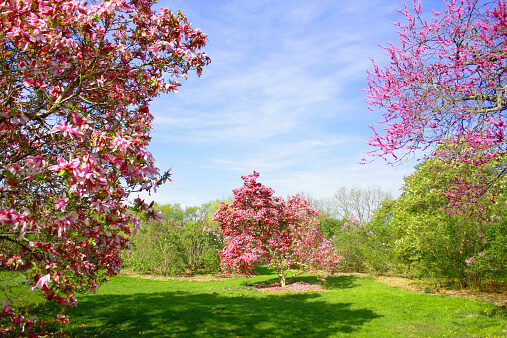
Care Tips for Your Magnolia Tree
Magnolia trees are prized around the world for the beautiful flowers they produce. Magnolia flowers are showy and fragrant, and come in a wide range of colors, including white, pink, red, purple, and yellow. There are magnolia varieties available for almost any climate, and the trees thrive in full sun to light shade, and moist, well-drained, and slightly acidic soils. Here are some tips to ensure that your magnolia tree thrives.
- Water trees regularly. Although most magnolia varieties will tolerate some dryness, extreme drought causes premature leaf drop and can threaten tree health. Mulch can be added to retain moisture and keep the roots cooler when temperatures are high. Ideally, the soil around the tree should be kept moist. This is especially critical for young trees, which need to be watered regularly and deeply.
- Balance out the soil. If your tree is planted in neutral soil and its growth is slow or weak, then it most likely needs to be fed with an acidic, slow-release fertilizer. In some cases, you can top dress the trees once a year as well with compost, peat moss, or well-aged manure. Just keep in mind that you should always strive to underfeed rather than overfeed to avoid burning the leaves.
- Treat against iron deficiency. While magnolia trees are usually resistant to most pests and diseases, they do have a tendency to develop chlorosis, which is basically an iron deficiency characterized by yellowing leaves (while the veins remain green). Regular applications of iron chelate will help protect the tree against this.
- Treat the root system with care. The roots of magnolia trees are more fragile than most and thus need to be treated with care. Any amendments need to be worked very lightly into the soil to avoid harming the roots. In addition, you should avoid walking or cultivating closely around magnolias, as this will not only disturb the roots but also compact the soil, which can be a detriment to tree health.
- Limit pruning. In magnolia trees, wounds heal slowly, so it’s best to keep pruning to a minimum. Prune broken branches as soon as possible, but be sure to put off all other pruning until after the tree has already flowered.
- Keep lawn mowers at a distance. It’s recommended that magnolia tree owners always take care to point lawn mowers and trimmers in such a way that the debris flies away from the tree. Magnolia tree bark and wood can easily be damaged by this debris, and the resulting wounds are easy entry points for insects and diseases.
For the most optimal results in growing healthy magnolia trees, it’s recommended that you do your research first to ensure that the variety is well suited to your region. With this and consistent care, you will be able to enjoy stunning magnolia blossoms year after year.